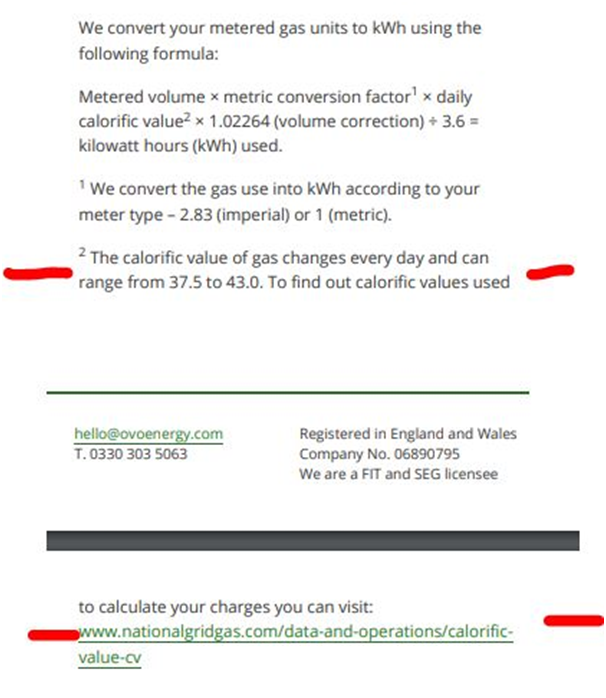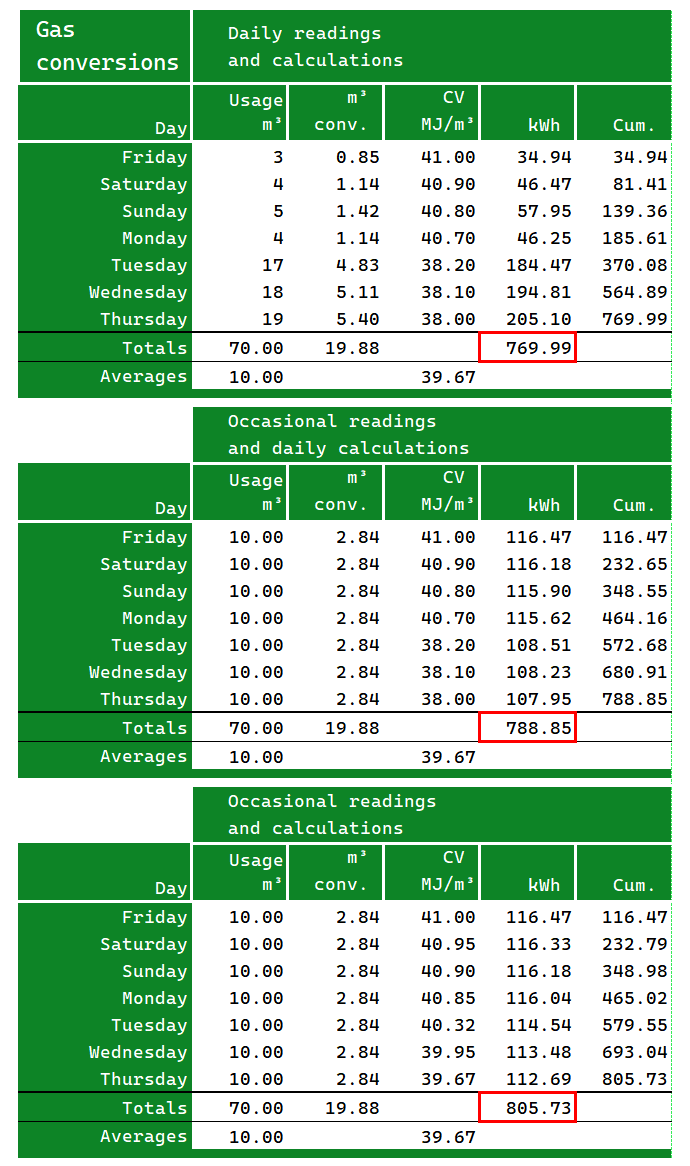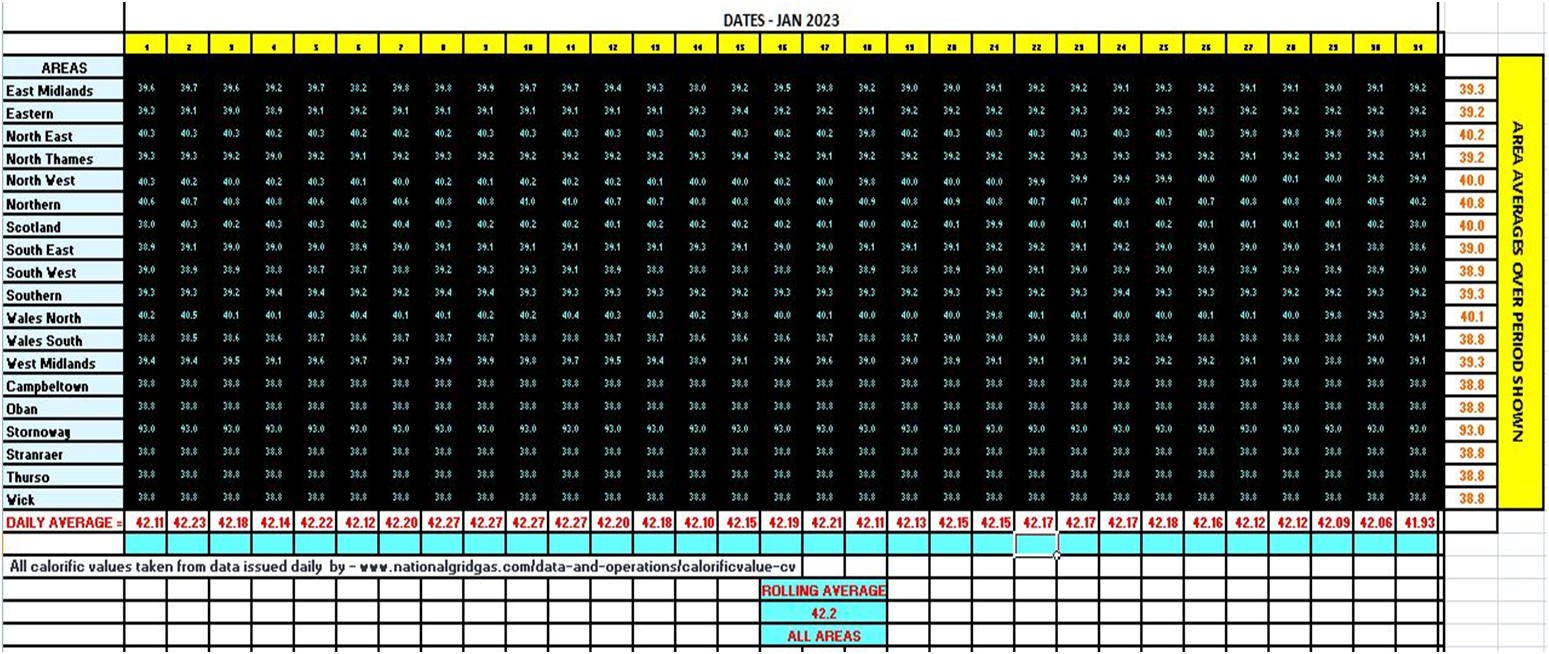Add Calorific values of gas to bills.
Further information in this thread
Add Calorific values of gas to bills.
Further information in this thread
Being newish to OVO, thanks for this idea Jeff's.
If you add more information about the reason it would be useful and what the change might look like it may help you.
Have a look at some of the other ideas as examples. It may help.
Jeffus.
The regulations state that energy companies have to use an average of the CV data over the period of a bill (1month, 1 quarter etc)
Actually on OVO bill at present is all the criteria to calculate/check the bill, except for the CV data.
What it does do is tell you look at the National Grid site to dig out the info for yourself. If you do this you have take CV figures for every day over the period of the bill, calculate an average and then use that average in your calculations to check cost.
Customers should not have to perform this rigmarole (if they wish to do their own check).
Simply put, it should be on the bill!
See attached section of OVO bill. Where it shows :-
(2 The calorific value of gas changes every day and can range from 37.5 to 43.0. To find out calorific values used),
This is where they should replace 37.5 to 43.0 with the actual CV used. As used to be the case. Why have they removed it because nothing has changed, OVO still had to work out an average which they did put on the bill.
All that is missing is the CV.
I don’t think any more can be given.
Thanks

Hey
I’ve changed this to ‘open for votes’ so we can gauge how others feel about this particular issue. 😊
I didn’t know myself until a few days ago that it was something we used to provide!
Hey
I’ve changed this to ‘open for votes’ so we can gauge how others feel about this particular issue. 😊
I didn’t know myself until a few days ago that it was something we used to provide!
I can't really take the credit for this. It is all the work of
I simply started the idea as i thought it would get more attention to guage demand than
Credit should go to
The regulations state that energy companies have to use an average of the CV data over the period of a bill
I don’t see that in the regulations. I do see how to calculate the average CV for a period, but nowhere does it say that suppliers have to use an average value over the period of a bill. If I were OVO, I’d devise a system where consumers submit meter readings no less frequently than once a day, then use those together with the published CV to calculate the day’s energy consumption and publish the results on the website. Otherwise, there will have to be some estimation, and that’s not popular, even though it should all come out in the wash eventually.
I mentioned elsewhere that it matters how the calculation is done. Here are three ways of doing it, with data contrived to illustrate the discrepancies that could arise over just a week. The scenario is a user who’s been away for a long weekend, coming home to a chilly house. Total consumption for the week is 70m³, and the CVs used are within the mandated bracket of 38-41MJ/m³ .

The ‘m³ con(verted)’ column is just the metered volume multiplied by the correction factor 1.02264 and by the MJ-kWh conversion 1000/3600. This multiplied by the CV gives the equivalent in kWh.
The results, outlined in red, are:
The cumulative figures in the last column simply indicate what might be shown on each day’s usage and billing pages on the account website.
I know which of these I think is the most accurate. You’ll note that the average CV for the week doesn’t change, so knowing this figure wouldn’t be much help in checking your bill. With gas costing 10p/kWh, the difference between the first and last methods amounts to more than £180 a year in my favour ...
Firedog Liking your work.
This what I gleaned how suppliers are to present CV and surmised that the onus is on the supplier to use the CV (from National Grid) averaged over a period and not a fixed “industry standard”.
guidance to suppliers on how to meet their obligations on using calorific value when billing customers. Guidance on the calculation of thermal energy on the basis of determined calorific values Use of average daily figures Regulation 3 (2) states that the “average calorific value of gas so conveyed during any such period shall be calculated by adding the daily values…for each gas day in that gas period and dividing by the sum of the number of those gas days…”. National Grid is responsible for determining the daily average CV for each charging area. National Grid publishes this daily average CV for each charging area rounded to one decimal place in accordance with Regulation 4 (4) (set out in Appendix 1). National Grid then transmits this daily calorific value electronically to gas transporters and gas suppliers for their respective uses. The daily CV provided to gas suppliers by National Grid should be the basis for calculating the average CV for any gas period. The CV used for consumer billing should be an average of the daily average values received from National Grid for the billing period. The use of a fixed CV, which some suppliers refer to as an ‘industry standard’, is not consistent with the Regulations. Requirement to truncate Regulation 3 (2) is clear that when calculating CV “any amount of less than 0.1 megajoules per cubic metre shall be ignored.” This means that for a given gas billing period, suppliers should truncate the average CV to one decimal place. Rounding average CV is not consistent with the Regulations, nor is calculating to more than one decimal place.
Below is what I have been using since 1st Jan. Each day CV from Nat. Grid entered. Bottom of each row National Daily Average. Red numbers in far right row (in this case for 31days Jan) show averages for each area. It gives the rolling average area CV automatically as the days are entered. Then I just enter the average area figure into another chart I have and that auto calcs. my correct usage. I had a call from someone within OVO who knew the ins/outs of how they use the CV data supplied to them. WE compared my data results with what they had and the results were the same, which gave me confidence to carry on with my own efforts. Their system does use averaged data and it was explained how. The difficulty for OVO at the moment is there system is not in a position put that onto a bill.
Sorry about the size of the image below. The only way , I think, to enlarge it is to copy/paste onto a word document.
Thanks again for your input.

Personally I’m not bothered about seeing the CV on my bill. If I knew that OVO and other gas suppliers were correctly audited on this I’d be happy.
I imagine they are and I am blissfully happy.
PS I’m not sure how you’re preparing images for upload from your Excel worksheets. Mine seem to come out quite clear; I use the Copy > Copy as picture > Bitmap feature from the Excel ribbon. If the image isn’t particularly big, it can be pasted into post here straight from the clipboard. If it’s very big, I paste it into Paint and save it as PNG, then upload that using the Insert image tool on the post editor’s toolbar.
There is a point in what you say “if you new that OVO were audited”.
As you will know Ofgem audit energy companies which was assured when OVO had to pay £8.5m for overcharging customers. So I can at least be confident that auditing is carried out.
My original question (not a complaint) about CV was why, having been an SSE customer and the CV was always on the bill and why was it removed from OVO bills (in 2021). Purely for accuracy for anyone wishing to calculate/check their own bills. Thanks to the efforts of OVO forum members and OVO systems operatives I have an in depth knowledge of how their computing system carries out continuous monitoring of Nat. Grid CV data.
Just to mention something I found out (you may already know) about Nat. Grid data, the values given daily, if back checked can be found to have been adjusted, which does add difficulty for OVO, so just taking the data daily is not necessarily going to be correct.
I am being rather pedantic and apologize for the length of my reply.
That said, I am happy with where I am now and pleased to say my OVO account has settled down now (other issues).
Hi
I have been trying out your method for posting an image. Not sure if you clicked on the image I posted but I hadn’t actually clicked on it before. I have just clicked on it and it does expand to a readable size, wasn’t aware it would do that. Was posted as a snipped image, saved as a jpeg.
Thanks again
That’s was Firedog’s advice - I can’t claim the credit !
Ask your question to our members - they have the experience you're looking for:
Ask our communityNo account yet? Create an account
Enter your E-mail address. We'll send you an e-mail with instructions to reset your password.
Sorry, we're still checking this file's contents to make sure it's safe to download. Please try again in a few minutes.
OKSorry, our virus scanner detected that this file isn't safe to download.
OK
